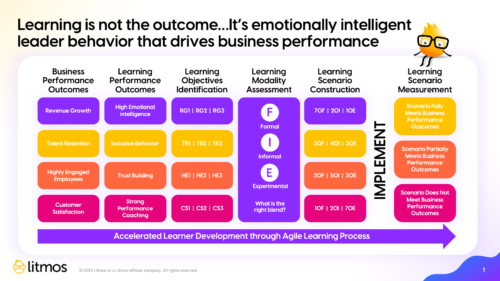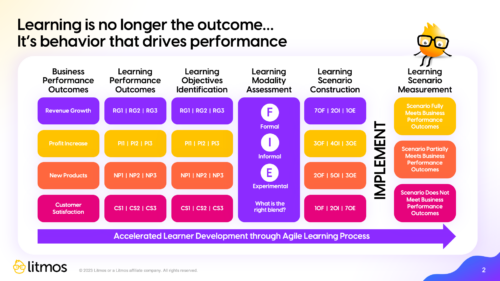Connecting Learning to Performance

Brandon Hall Group Platinum Preferred Provider Litmos recently sponsored a webinar to explore this topic. Matt Pittman, Principal Analyst with Brandon Hall Group was joined by Ryan Morris and Adele Pfister from Litmos to talk about how learning teams can work with business stakeholders to ensure learning programs are on target. Below are the highlights from our discussion.
Learning Performance Convergence Model
As an anchor point for the conversation, the panel focused on the key elements of Brandon Hall Group’s Learning-Performance Convergence Model, shown below.
The Learning-Performance Convergence Model shows how to connect learning to performance. The model is based on the results of multiple studies conducted by Brandon Hall Group, as well as engagements with leading-edge companies, solution providers and thought leaders. This is updated with the latest research by Brandon Hall Group.
In Brandon Hall Group research, the overwhelming majority of companies that take a blended approach to learning see an improved link between learning and individual performance (95%), and organizational performance (91%). Within the context of the Learning-Performance Convergence Model, companies must understand that:
- Blended learning is not a by-the-numbers application of 70:20:10.
- Blended learning is not a sequential roll-out of formal first, then informal, then experiential.
In the Learning-Performance Convergence Model, the mix of learning types changes from program to program, depending on the desired performance outcome.
Conversation Highlights
This was a broad reaching and far-ranging conversation about all aspects of delivering and measuring learning for impact. The focus was really on how to engage in the process of making sure learning, expectations, and outcomes all come together to move the needle on performance.
Below are some of the key ideas:
-
Build strong relationships with stakeholders.
When you are seen as a strong business partner, you can engage in deeper conversation about the business result that needs to be impacted by training. The stronger the relationship, the more questions you can ask. The more questions you ask, the better you can understand how the learner needs to perform differently and how you will know they are. This also allows you to effectively manage the expectations of your stakeholders. The stakeholder relationship is also what can help you move the needle on new approaches or technology in learning as well as gain access to the data you need to accurately measure the impact of the training.
A working understanding of the goals of the business is critical. It is not enough to ask what they are. Learning & Development (L&D) leaders must work closely with the business to determine what talent and learning objectives are required to meet business goals. Even the smallest, seemingly insignificant learning program must have a business reason to exist. For example, it is not enough to deploy a program on improving communication skills simply because it is a nice thing to have. L&D must articulate the business implications of good communication and use that as an impetus for the program.
-
Take a systematic approach to the process of aligning learning.
Which approach you take to your training design and measurement is less important than the fact that you need to have an approach. Whether you follow ISD, Agile techniques, continuous improvement, ALA, or something else – have a consistent approach and use it. Know what questions you are asking and who you are asking them to. If you come from a place of not knowing, meaning you assume that you don’t know the answer even if you might, you will ask more and better questions. Keep the process consistent and you will also teach your partners in the business how to work with you to meet their needs.
Organizations must do a better job of identifying and defining the skills and competencies required to make the business successful. This is the first stage in turning business outcomes into learning objectives. By defining what mastery is, the company has a target for the learning programs. A lack of specificity makes learning programs hit or miss and keeps the organization operating on the assumption that the programs are effective simply because they exist.
-
Contextualize learning for your business, your learner, and the problem you are solving.
This is important because the experience is where you learn. Peer to peer sharing of information is a critical component to how our brains work. It is also critical that learners be able to practice skills in a safe space. Allowing for connection in the learning, to internalize and process with another person will make a huge difference to the impact that learning has on the learner and ultimately on the business.
Quite often, organizations establish learning objectives for their programs without making the connection to talent or business objectives. Learning programs should be designed to develop or improve specific behaviors that will drive performance. It is not enough to ensure that people took a course, passed an assessment or liked the program. Learning initiatives should point to specific, measurable outcomes. For example: A demonstrable knowledge of a new sales technique, ability to identify all features of a new product/service, and an understanding of the use of a new software platform.
Conclusion
Learning leaders are business leaders. If you are reading this and you are a learning leader, be reminded that you are a business leader. You must think like and act like a business leader first. Speak the language of business inside the language of learning. Your deliverables are the company’s deliverables, and your team has a critical role to play in the success of the business in the long term.
If you are a business unit or executive leader reading this, do not underestimate the power of your learning team to get you where you need to be. Whether that is in ensuring early success in new hires or upskilling entire teams to keep pace with changes in technology, your learning teams are uniquely positioned to help you navigate these times. Work with them to build a learning model that will serve the needs of your organization now and into the future.
If the first few years of the 2020’s has taught us anything, it is that adapt or die is no mere pithy quote. It is a mandate, a mantra if you will, that truly ensures survival. Learning teams must grow beyond their historical and traditional approaches and build stronger partnerships with business stakeholders. They must also have structures and workflows that are agile and responsive to frequent change.
In that same vein, business leaders must change their thinking about the role of L&D in the delivery of results and respond favorably when the team creates successful outcomes.
Working together is the only way to ensure success.
Continue to focus on asking a few key questions. When you begin with the end (the business result) in mind, L&D professionals can ensure the learning experiences they are producing are meeting the needs of the business, which is the first goal. Then you can also respond to the preferences of the learners and generate data that will demonstrate impact.
Interested in tuning into the full webinar? You can find a link to the webinar recording here.






